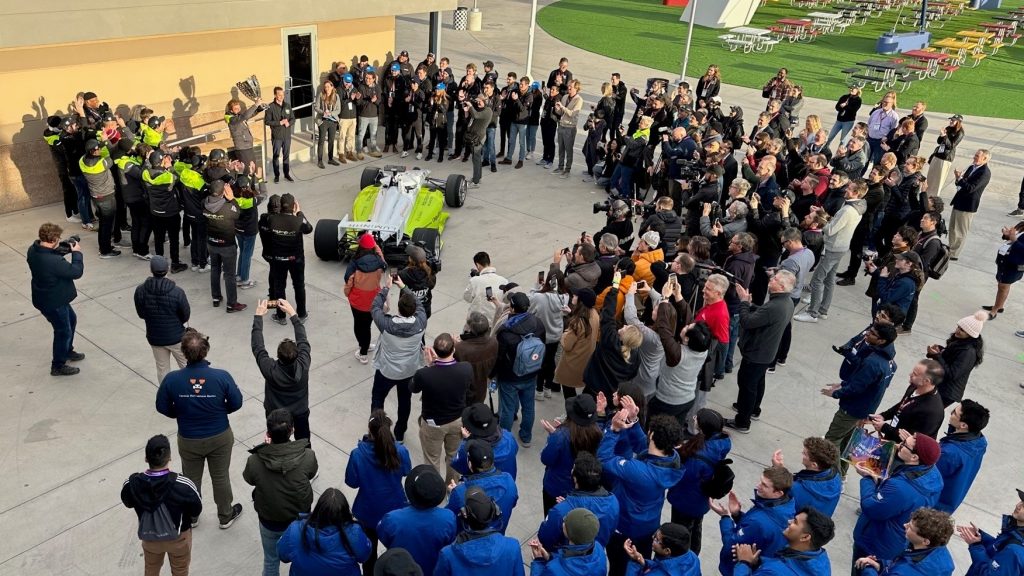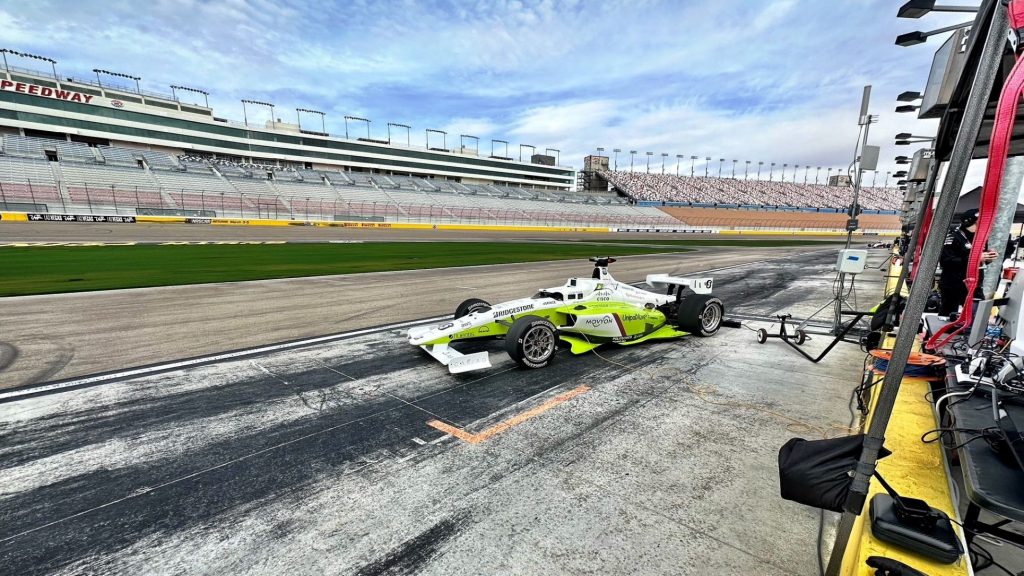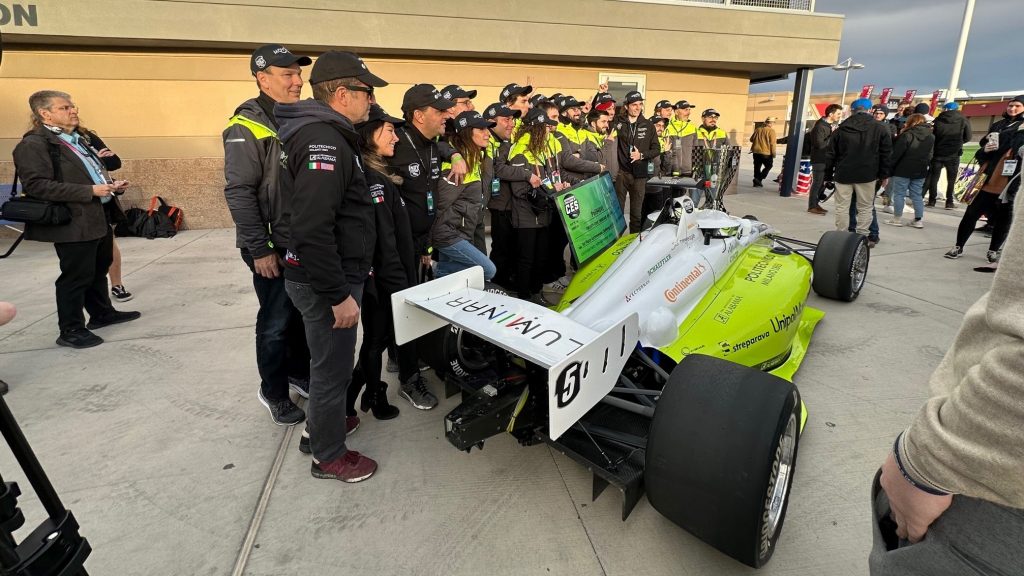
After a week of on-site testing at the Las Vegas Motor Speedway, Indy Autonomous Challenge (IAC) team PoliMOVE won the second annual Autonomous Challenge @ CES held on January 7th. The team made up of autonomy-focused students and faculty from Politecnico di Milano in Italy and the University of Alabama reached max speeds of 180 mph—a new speed record for the IAC on a racetrack. This follows the team’s November victory at the IAC competition at the Texas Motor Speedway.
Pushing boundaries of head-to-head autonomous racing, PoliMOVE competed at the Las Vegas Motor Speedway against a field of nine teams from 17 universities spanning six countries all seeking to break autonomous racing records. TUM Autonomous Motorsport from Technische Universität München in Germany took second place. Placing third was AI Racing Tech, a team combining the resources of the University of Hawai’i; the University of California, San Diego; Carnegie Mellon University; and the University of California, Berkeley. Coming in fourth was MIT-PITT-RW, the only all-student-led team from the Massachusetts Institute of Technology, the University of Pittsburgh, the Rochester Institute of Technology, and the University of Waterloo.

Rounding out the six teams that made it to the racing round were KAIST (Korea Advanced Institute of Science and Technology) from South Korea and TII EuroRacing—combining the University of Modena and Reggio Emilia with the Technology Innovation Institute. Teams in Las Vegas that did not advance to Saturday’s final competition were Autonomous Tiger Racing from Auburn University, Black & Gold Racing from Purdue University, and Cavalier Autonomous Racing from the University of Virginia.
The IAC competition rules call for a single elimination tournament with multiple rounds of head-to-head passing matches culminating in a championship round. Each team used a Dallara AV-21, the world’s fastest autonomous racecar, creating the AI driver for the common hardware platform.
At the track, they took turns playing the role of leader/defender and passer/follower/attacker in front of a crowd of CES 2023 attendees. Passes were attempted at increasing speeds until one or both cars were unable to successfully complete a pass. The rules required each team to qualify in a high-speed time trials competition that determined their seedings in the head-to-head passing competition.
Six of the nine teams made it to the head-to-head competition stage on Saturday.
“Exactly 365 days later, we were so proud and excited to be back in Las Vegas for the Autonomous Challenge @ CES,” said Prof. Sergio Savaresi, team lead of Politecnico di Milano. “Today was a major step forward in speed, in complexity of the race, and in overcoming challenging head-to-head situations. We are very glad for this success, for the contribution of the Indy Autonomous Challenge, and for all the teams in advancing the technology of AI drivers.”

The IAC is working to accelerate the pace of innovation for high-speed automation, with a goal of attracting the best and brightest minds in the workforce, serving as a platform for students to excel in STEM (science, technology, engineering, and math) and inspire the next generation of innovators. Collaborating with premier sponsors Aspire, Cisco, and Luminar, the IAC aims to increase safety and performance in not only motorsports but also across all modes of commercial transportation.
“We came to the world’s most influential innovation event this week, CES, to showcase to the entire technology ecosystem how this program and this competition is catapulting autonomous technologies forward,” said Paul Mitchell, President, IAC. “We’re harnessing the power of head-to-head competition to push and test the limits of autonomous driving to further the state-of-the-art technology in safety and performance of automated vehicles, and today we snagged yet another world record.”
Enthusiasm for the IAC competition has been growing. More than 30 university teams initially signed up to compete more than two years ago, representing top engineering and technology programs from 15 U.S. states and 10 countries. The competition made history in October 2021 when it held the Indy Autonomous Challenge Powered by Cisco, the first high-speed autonomous racecar competition at the Indianapolis Motor Speedway (IMS).
The global scope and diversity of the competition will take on even greater focus in 2023 as the IAC announced at CES that it will partner with the Milan Monza Motor Show (MIMO) in taking the autonomous racecars to a road course competition later in the year. The IAC will run on the famed Monza F1 circuit, the oldest racing circuit in Europe, in a push beyond the oval tracks used so far for the competition.
“MIMO is the perfect partner to make the transition from ovals to road courses happen,” said Mitchell. “This two-year partnership between IAC and MIMO will allow us to showcase our racecars in exhibition runs in June 2023 as our teams and their AI drivers learn to run on road courses, and then in June 2024 we will return and host our first proper road course racing competition at Monza, the Temple of Speed.”
The IAC will add a dynamic element to the MIMO 2023 show, which aims to promote the knowledge and diffusion of new technologies in all areas of research.
“The Formula 1 circuit and the old, banked ones that we will use for test drives will be the stage for a special Formula Indy race, with self-driving single-seaters, engaged for the first time in a technical circuit with curves and chicanes,” said Andrea Levy, President, MIMO Motor Show. “Monza will be the venue for an incredible challenge between the best universities and research centers from all over the world.”
In addition to advancing to road competition, the IAC announced at CES plans to transform its current Dallara AV-21 racecar into an improved AV-23. The switch to AV-23 will be complete before the end of 2023 but will be done in phases to allow for testing and validation of new and/or updated systems.
The IAC’s roster of member sponsors AWS, Bridgestone, Cisco, Continental, and Luminar, together with other technology sponsors such as dSPACE and VectorNav, will help transform the current racecar into the AV-23 with advanced automation hardware and software, improved system integration, and packaging that is more durable and easier to maintain.
The AV-23 transformation has already started with a new central computer from dSPACE and a new GNSS/GPS unit from VectorNav. Other vehicle technology that will be enhanced includes new radar systems from Continental, updated lidar systems from Luminar, advanced racing tires for both oval and road course performance from Bridgestone, and a new aero kit and other vehicle modifications from Dallara. Infrastructure improvements will come from enhanced communications and networking solutions from Cisco and cloud computing and data analytics from AWS.
IAC’s efforts to inspire entrepreneurship and empower the next generation of brilliant minds to lead the autonomous vehicle industry will get a boost with the re-launch of its SIM races on the AWS Cloud. This highly accurate simulation environment is key for university teams to innovate, test AI algorithms in a controlled environment, navigate safely, and increase the chances for success should they eventually progress to on-track competitions.

